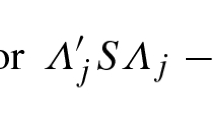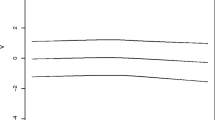Abstract
Situations sometimes arise in which variables collected in a study are not jointly observed. This typically occurs because of study design. An example is an equating study where distinct groups of subjects are administered different sections of a test. In the normal maximum likelihood function to estimate the covariance matrix among all variables, elements corresponding to those that are not jointly observed are unidentified. If a factor analysis model holds for the variables, however, then all sections of the matrix can be accurately estimated, using the fact that the covariances are a function of the factor loadings. Standard errors of the estimated covariances can be obtained by the delta method. In addition to estimating the covariance matrix in this design, the method can be applied to other problems such as regression factor analysis. Two examples are presented to illustrate the method.
Similar content being viewed by others
References
Arminger, G., & Sobel, M.E. (1990). Pseudo-maximum likelihood estimation of mean and covariance structures with missing data.Journal of the American Statistical Association, 85, 195–203.
Anderson, T.W. (1957). Maximum likelihood estimates for a multivariate normal distribution when some observations are missing.Journal of the American Statistical Association, 52, 200–203.
Bekker, P.A., Merckens, A., & Wansbeek, T.J. (1994).Identification, equivalent models and computer algebra. Boston, MA: Academic Press.
Bishop, Y.M.M., Fienberg, S.E., & Holland, P.W. (1989).Discrete multivariate analysis. Cambridge, MA: MIT Press.
Bollen, K.A. (1989).Structural equations with latent variables. New York: Wiley.
Brown, C.H. (1983). Asymptotic comparison of missing data procedures for estimating factor loadings.Psychometrika, 48, 269–291.
Browne, M.W. (1988). Properties of the maximum likelihood solution in factor analysis regression.Psychometrika, 53, 585–590.
Finkbiner, C. (1979). Estimation for the multiple factor model when data are missing.Psychometrika, 44, 409–420.
Gleser, L.J., & Olkin, I. (1973). Multivariate statistical inference under marginal structure.British Journal of Mathematical and Statistical Psychology, 26, 98–123.
Gulliksen, H. (1950).Theory of mental tests. New York: Wiley.
Holland, P.W., & Wrightman, L.E. (1982). Section pre-equating: A preliminary investigation. In P.W. Holland & D.R. Rubin, (Eds.),Test equating (pp. 271–297). New York: Academic.
Lawley, D.N., & Maxwell, A.E. (1971).Factor analysis as a statistical method. New York: American Elsevier.
Lawley, D.N., & Maxwell, A.E. (1973). Regression and factor analysis.Biometrika, 60, 331–338.
Lee, S.-Y. (1986). Estimation for structural equation models with missing data.Psychometrika, 51, 93–99.
Little, R.J.A. (1988). Robust estimation of the mean and covariance matrix from data with missing values.Applied Statistics, 37, 23–38.
Little, R.J.A. (1992). Regression with missing X's: A review.Journal of the American Statistical Association, 87, 1227–1237.
Little, R.J.A., & Rubin, D.B. (1987).Statistical analysis with missing data. New York: Wiley.
Little, R.J.A., & Schenker, N. (1995). Missing data. In G. Arminger, C.C. Clogg, & M.E. Sobel (Eds.),Handbook of statistical modeling for the social and behavioral sciences (pp. 39–69). New York: Plenum.
Lord, F.M. (1955a). Equating test scores—A maximum likelihood solution.Psychometrika, 20, 193–200.
Lord, F.M. (1955b). Estimation of parameters from incomplete data.Journal of the American Statistical Association, 50, 870–876.
Lord, F.M., & Wingersky, M.S. (1971). Efficiency of estimation when there is only one comon factor.British Journal of Mathematical and Statistical Psychology, 24, 169–173.
McArdle, J.J. (1994). Structural factor analysis experiments with incomplete data.Multivariate Behavioral Research, 29, 409–454.
Muthén, B., Kaplan, D., & Hollis, M. (1987). On structural equation modeling with data that are not missing completely at random.Psychometrika, 52, 431–462.
Neale, M.C. (1993).Mx structural equation modeling. Richmond, VA: Medical College of Virginia.
Olkin, I. (1981). Range restrictions for product-moment correlation matrices.Psychometrika, 46, 443–459.
Rovine, M.J. (1994). Latent variables models and missing data analysis. In A. von Eye & C.C. Clogg (Eds.),Latent variables analysis. Thousand Oaks, CA: Sage.
Rubin, D.B., & Szatrowski, T.H. (1982). Discussion of “Section pre-equating: A preliminary investigation.” In P.W. Holland & D.R. Rubin, (Eds.),Test equating (pp. 301–306). New York: Academic.
Rubin, D.B., & Thayer, D. (1978). Relating tests given to different samples.Psychometrika, 43, 3–10.
Thayer, D.T. (1983). Maximum likelihood estimation of the joint covariance matrix for sections of tests given to distinct samples with application to test equating.Psychometrika, 48, 293–297.
Trawinski, I.M., & Bargmann, R.E. (1964). Maximum likelihood estimation with incomplete multivariate data.Annals of Mathematical Statistics, 35, 647–657.
Author information
Authors and Affiliations
Corresponding author
Additional information
This research was partially supported by NIMH grant MH5-4576
Rights and permissions
About this article
Cite this article
Cudeck, R. An estimate of the covariance between variables which are not jointly observed. Psychometrika 65, 539–546 (2000). https://doi.org/10.1007/BF02296344
Received:
Revised:
Issue Date:
DOI: https://doi.org/10.1007/BF02296344




